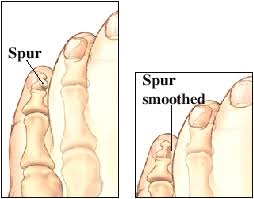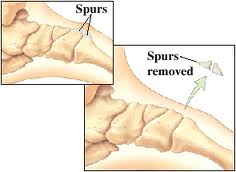Connect With Us
Spurs
What are bone spurs?
Bone spurs are small bony growths, also known as osteophytes or enthesophytes, that can occur anywhere in the body. Common places are the spine, shoulders, hips, knees, and the feet. Bone spurs typically occur at areas of damaged cartilage or joints (osteophytes) or at attachments of ligaments or tendons (enthesophytes). Bone spurs are a very common foot problem. In the feet, they develop most frequently in the heel, near the toes, on top of the big toe joint, and on top of the midfoot. Even though the spurs are small outgrowths of bone, their location may cause friction or irritation from shoes or other foot structures, which can lead to other foot problems.


Heel spurs refer specifically to bone spurs in the heel. Heel spurs are growths of bone on heel bone and occur when the plantar fascia pulls at its attachment to the heel bone, as in plantar fasciitis. There is a misconception that people with heel pain are hurting because they are walking on a spur. But in fact, the pain is merely from the inflammation around the spur, not the spur itself.
What are some signs and symptoms of spurs?
Typically, pain from a spur comes from direct pressure. Shoe gear may irritate the area as well. There may even be bursa or callus formation over the spur. Your body may produce these to help cushion the spur from the pressure.
How do you treat a bone spur?
Usually, just removing the cause of pressure on the spur will result in great relief. Sometimes over-the-counter anti-inflammatory medications can be useful.
Anti-inflammatory medications, cortisone injections, corrective shoes, and/or orthotics (special shoe inserts) are all common treatments for spurs.
Note: Please consult your physician before taking any medication.
If these conservative measures fail, sometimes surgery is necessary to shave down the bone spur.
If you think you have a bone spur, contact a Foot and Ankle Specialist to find out which treatment options are best for you.
